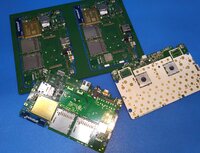levi
Still fresh, damnit!
For wavers, I assume you mean wafers, a term that usually applies to the thing inside modern integrated circuits, but I guess you're using it to describe the stacking of the multilayer boards - the bare PCBs. For some reason, CC with the pandora made all of the PCBs first then populated them, much later it turned out. I don't believe GC work like that, everything remains as data until it's ready to go then pcb etching and lamination happens, via's are punched, and then it goes straight through to population. I guess delays between stages might need to be managed, as glue takes time to dry, and washing off the etching fluid will need to be absolutely dry before lamination and gluing up, and it might not stay under the control of the machines all through those stages, it might well go into a bin and then be fed into the next machine, or it might be more like the 'inside the factory' shows I've watched where they have big spiral stacks for drying stuff out, and big long machines for baking, which the cakes and what have you travel through, which'd be more like for melting the solder paste in our factory. Sometimes doughs and things are made in a separate part and then wheeled through, but once everything is fed through to the production line nothing stops moving until it's being wrapped and loaded onto the van.


